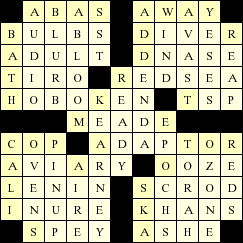Anatomy of a Classic Crossword PuzzleA classic specimen has two eye-catching grids of smaller squares which are (a) entirely black, (b) essentially blank, or (c) already filled in with individual letters.One in six squares are blackened in a symmetrical pattern, while left-to-right or above-to-below runs of the remaining squares harbor variously-sized niches for words across or down. All of the words are mutually contingent, since those niches that do not actually intersect are still connected by one or more degrees of separation.
Publishing ConventionsThe sibling grids are published separately - the solution grid of one crossword puzzle is typically published along with the puzzle grid of the next crossword puzzle, and so on - in order to discourage furtive glances at the solution.
CluesA crossword puzzle also has two tables of binary clues. The pairs of niche handles and word definitions in the table labeled Across both situate and define the words intended for the niches laid out left-to-right in the puzzle grid. Those in the table labeled Down do likewise for the words belonging in the orthogonal niches oriented above-to-below there.
A good clue is either obscure or ambiguous. One has to mentally stretch to think of even a single word that fits an obscure definition. Unless you grew up in North Jersey — or have memorized the locations where The Sopranos was filmed — 17 down is an example of an obscure definition of a word. On the other hand, an ambiguous definition brings many words to mind. Unless you are a teetotaler, 27 down is an example of an ambiguous definition of a word. MethodologyFill out the puzzle grid. Solve the crossword puzzle niche by niche. Think of words that simultaneously satisfy (a) the pattern of black and white squares, (b) both tables of binary clues, and (c) the orthogonal word templates formed by the words that you have already lodged in the puzzle grid.Set your words directly into the puzzle grid.
Word TemplatesIn the process of filling out the puzzle grid, the array of orthogonal word templates developing there may either seem promising and help complete the remaining niches, or else seem hopeless and signal you to backtrack and try again.If Only Life Was Always So EasyHere is a fortuitous example of a series of more restrictive templates in a four-letter niche intended for a word defined as Romp:
|

